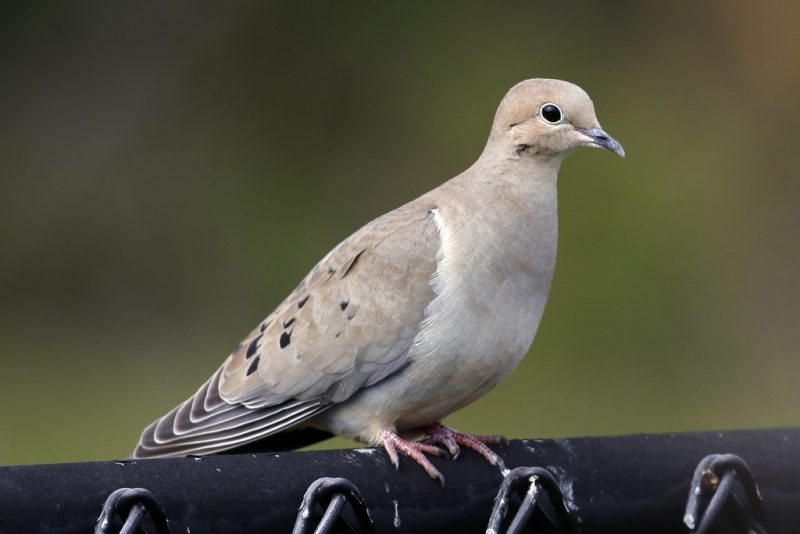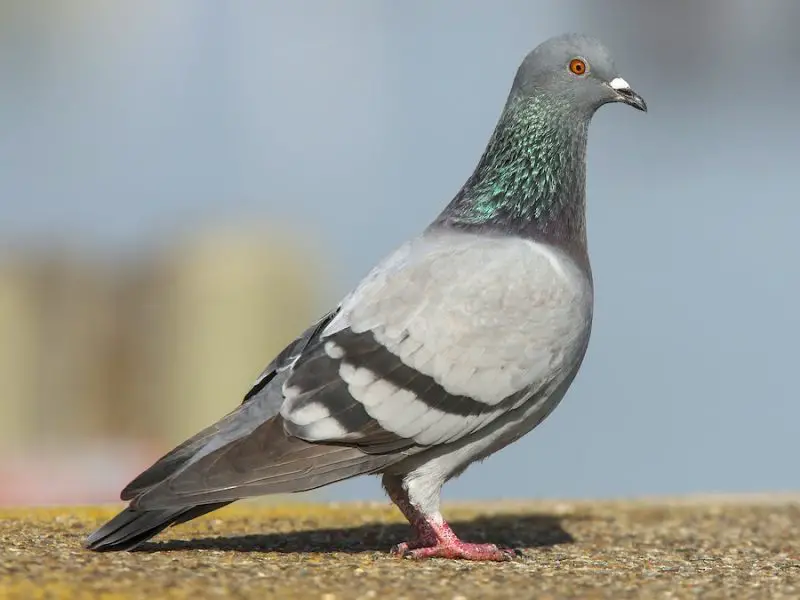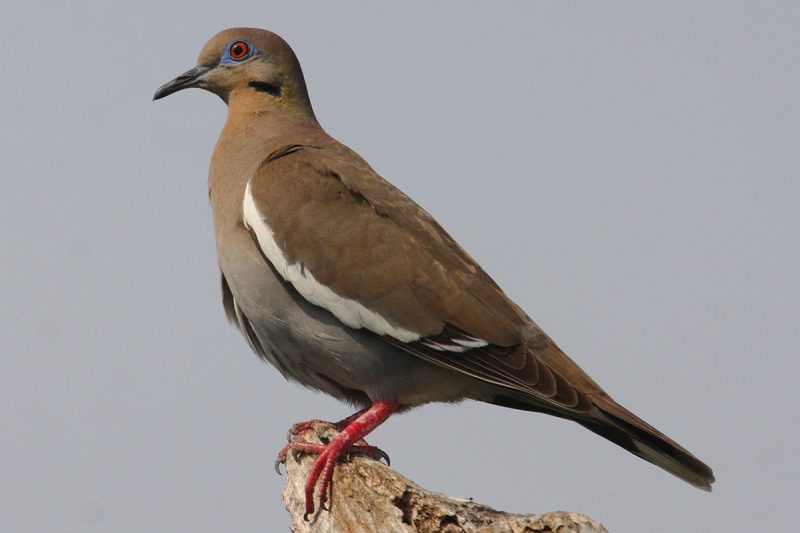Graceful and gentle, doves are among the most familiar birds across Illinois. Their soft cooing calls and calm behavior make them a favorite sight in fields, towns, and even city streets. With their adaptability, these birds have become a year-round presence in the state’s diverse landscapes.
Illinois is home to several dove species, each with unique characteristics, plumage, and habits. Some are native residents that nest in woodlands and suburbs, while others are introduced birds that thrive in agricultural and urban areas. Observing them closely reveals fascinating details about their behavior and survival.
From the widely recognized Mourning Dove to the rarer White-winged Dove, birdwatchers in Illinois can encounter different types throughout the seasons. Learning how to identify them by size, markings, and calls enriches the birding experience and brings new appreciation for these peaceful birds.
Common Doves Found in Illinois
Mourning Dove (Zenaida macroura)

The Mourning Dove is by far the most common and recognizable dove in Illinois, seen across the state year-round. It has a slim, graceful body with soft brown and tan plumage, accented with black spots on the wings. The bird’s long, tapered tail with white edges makes it easy to identify in flight, where it often shows quick, darting wingbeats followed by short glides. Adults usually measure around 9 to 13 inches long, with a wingspan of 17 to 18 inches, and weigh close to 4 ounces. Their eyes are dark, with a delicate blue ring of skin that adds to their gentle appearance.
Behaviorally, Mourning Doves are known for their calm and peaceful nature. They feed mostly on the ground, searching for seeds, grains, and occasionally small fruits. Their flight is swift and direct, and when startled, they often take off with a characteristic whistling sound made by their wings. They are prolific breeders, often raising multiple broods each season, and are commonly seen nesting on tree branches, ledges, or even in hanging flower pots around homes.
In terms of habitat, Mourning Doves are highly adaptable and can thrive in urban, suburban, and rural areas alike. They are often spotted along roadsides, in fields, and at backyard feeders. In Illinois, they are present year-round and play an important role in the ecosystem by dispersing seeds across wide areas. Their adaptability to both natural and human-modified environments has allowed them to become one of the most abundant dove species in North America.
A fun fact about the Mourning Dove is that despite their fragile appearance, they are one of the most hunted game birds in the United States. Millions are harvested each year, yet their population remains strong due to their rapid reproductive rate. Their soft, mournful cooing, from which they get their name, is one of the most familiar bird sounds in Illinois and often associated with calm summer mornings.
Eurasian Collared-Dove (Streptopelia decaocto)

The Eurasian Collared-Dove is a non-native species in Illinois, having spread across the United States after first being introduced in the Bahamas in the 1970s. Larger than Mourning Doves, these doves measure around 11 to 12 inches long with a wingspan of about 18 inches. Their plumage is pale gray to beige, with a slightly lighter belly and a squared tail that shows broad white tips in flight. Their most distinctive feature is the black half-collar on the back of the neck, which gives the species its name.
Unlike Mourning Doves, Eurasian Collared-Doves are often found in more human-dominated environments. They prefer towns, suburbs, and agricultural areas, where they can easily find grain and seeds. They are frequently seen perched on power lines, rooftops, or fence posts, where their presence is announced by a repetitive three-note cooing call that sounds like “coo-COO-coo.” This call is an excellent way to distinguish them from Mourning Doves, whose song is more mournful and flowing.
In Illinois, Eurasian Collared-Doves are not as widespread as Mourning Doves, but their population is steadily growing. They are more often encountered in southern and central Illinois, especially near farmlands where spilled grain provides an abundant food source. Their expansion across the continent has been remarkably fast, showing just how adaptable and resourceful this species is.
A fun fact about Eurasian Collared-Doves is their history of rapid colonization. Originally native to Asia and parts of Europe, they expanded their range dramatically during the 20th century. Their name “decaocto” comes from Greek, meaning “eighteen,” which relates to an old legend about a servant girl whose lament was transformed into the dove’s call. Today, these doves are a symbol of resilience and adaptability, thriving in landscapes modified by humans.
Rock Pigeon (Columba livia)

The Rock Pigeon, also called the common pigeon, is another dove species found across Illinois, especially in urban settings. These birds vary widely in appearance due to centuries of domestication and selective breeding, but the wild-type coloration is bluish-gray with two black wing bars and an iridescent green-and-purple sheen around the neck. They are relatively large compared to Mourning Doves, averaging 11 to 14 inches in length, with a wingspan of 19 to 26 inches. Their sturdy bodies and short, rounded tails make them easy to recognize.
Behaviorally, Rock Pigeons are highly social and are often seen in flocks, sometimes numbering in the hundreds. They feed primarily on seeds, grains, and human food scraps, which explains their abundance in cities. They are strong fliers and can travel long distances, a trait that made them useful as messenger birds for centuries. Their nesting habits are flexible—they will use building ledges, bridges, barns, and cliffs to raise their young. Pigeons often raise several broods a year, making them successful colonizers of urban areas.
In Illinois, Rock Pigeons are most abundant in cities such as Chicago and Springfield, but they can also be found in smaller towns and rural farm buildings. They are not native to North America; they were introduced by European settlers in the 1600s. Over time, they have become naturalized and are now considered part of the urban landscape. Despite being common, they are important scavengers, helping to clean up spilled grain and food waste.
A fun fact about Rock Pigeons is their incredible homing ability. They can find their way back to their nests from hundreds of miles away, even when released in unfamiliar areas. This skill made them invaluable during wartime for delivering messages, and some pigeons even received medals of honor for their service. Their long relationship with humans makes them one of the most historically significant birds in the world.
White-winged Dove (Zenaida asiatica)

The White-winged Dove is less common in Illinois, but occasional sightings occur, particularly during summer migration periods. They are medium-sized doves, slightly larger than Mourning Doves, measuring around 11 inches long with a wingspan of about 18 inches. Their plumage is light brown to gray, but their most distinctive feature is the bold white stripe along the edge of the folded wing, which becomes a striking white flash in flight. They also have a blue eye ring and red eyes, giving them a unique appearance among doves.
White-winged Doves are primarily found in the southwestern United States, Mexico, and Central America, where they thrive in deserts, woodlands, and agricultural areas. Their diet consists mostly of seeds, grains, and fruits, and in some regions, they are important pollinators for plants such as the saguaro cactus. They are also frequent visitors to backyard feeders, where they can be seen alongside Mourning Doves. In Illinois, they are rare visitors, usually appearing in southern counties and during unusual northward migrations.
Their behavior is generally similar to Mourning Doves, with quick, direct flight and ground-feeding habits. However, they are more vocal, producing a distinctive “who-cooks-for-you” call that stands out compared to the softer coos of other doves. These calls can sometimes confuse birdwatchers unfamiliar with the species. Their increasing presence in the Midwest suggests that climate change and habitat shifts may be helping them expand their range northward.
A fun fact about the White-winged Dove is its cultural significance in music. It was famously referenced in Stevie Nicks’s song “Edge of Seventeen,” where the bird’s distinct call inspired the line “just like the white-winged dove.” This species has long been admired for both its beauty and its song, making it one of the more charismatic doves found in North America.
Best Places and Times to See Doves in Illinois
Doves are widespread in Illinois, but the chances of spotting each species vary depending on location and season. The Mourning Dove, being the most common, can be seen almost anywhere across the state throughout the year. They are especially abundant in open fields, along roadsides, and in suburban backyards where bird feeders provide a steady food source. Agricultural areas in central and southern Illinois are particularly reliable spots, as the birds often forage on spilled grain after harvest.
The Eurasian Collared-Dove is best seen in small towns, farmsteads, and grain-handling facilities, where they gather in noticeable numbers. Their preference for human-modified landscapes makes them easier to find around barns, silos, and telephone poles. Southern Illinois tends to host more of these doves, but their numbers are slowly spreading northward as their population grows. Their repetitive three-note call is often the first clue that one is nearby, especially during spring and summer.
Rock Pigeons, on the other hand, are most commonly observed in cities such as Chicago, Springfield, and Peoria. They thrive in urban environments, where tall buildings and bridges serve as perfect nesting spots. Downtown areas, train stations, and parks with people feeding birds are hotspots for viewing Rock Pigeons at close range. Unlike other doves, they are active year-round and can be seen in large flocks, making them one of the most visible species in Illinois.
The White-winged Dove is a rare visitor to Illinois, but birdwatchers occasionally spot them during the warmer months, especially from late spring through summer. Southern Illinois, with its warmer climate and mix of fields and woodlands, offers the best chance for sightings. Because this species is expanding northward, reports are becoming more frequent, particularly at backyard feeders where they sometimes mingle with Mourning Doves. Keen birders should watch migration reports and local birding networks to catch these unusual appearances.
In general, the best time of day to observe doves in Illinois is early morning and late afternoon. These are the peak feeding periods, when doves are most active in open fields, backyards, and along roadsides. Winter is excellent for spotting Mourning Doves and Rock Pigeons, as they often form larger flocks, while spring and summer provide opportunities to see Eurasian Collared-Doves and the occasional White-winged Dove. With their adaptability to both wild and urban landscapes, doves offer Illinois birdwatchers rewarding encounters throughout the year.
FAQs about Doves in Illinois
Do Mourning Doves migrate in Illinois?
Mourning Doves are year-round residents in Illinois, but some individuals do migrate south for the winter. Northern populations tend to travel to the southern United States or even Central America, while many Illinois birds stay put if food remains available. Their adaptability allows them to survive cold months by forming large flocks and feeding on leftover seeds in fields and backyards.
What do doves eat in Illinois?
All dove species in Illinois primarily eat seeds and grains, making agricultural fields and bird feeders excellent food sources. Mourning Doves often forage on the ground for millet, sunflower seeds, and cracked corn, while Eurasian Collared-Doves and Rock Pigeons readily consume spilled grain around silos and barns. White-winged Doves, when present, eat similar foods but also take fruits and berries during summer.
Do doves visit backyard feeders?
Yes, doves are frequent visitors to backyard feeders in Illinois, especially Mourning Doves. They prefer platform feeders or seed scattered on the ground, as their larger bodies make it difficult to perch on small hanging feeders. Eurasian Collared-Doves also visit feeders, and on rare occasions, White-winged Doves may appear, giving lucky birdwatchers an unusual backyard sighting.
Where are doves most commonly seen in Illinois?
Mourning Doves are found statewide in fields, suburban yards, and along roadsides, making them the most widespread dove in Illinois. Rock Pigeons dominate city centers, bridges, and urban parks, while Eurasian Collared-Doves are more likely in rural areas with farms and grain silos. White-winged Doves are uncommon, but sightings are most likely in southern Illinois during the warmer months.
Are doves active year-round in Illinois?
Yes, three species—Mourning Doves, Eurasian Collared-Doves, and Rock Pigeons—are present throughout the year in Illinois. Their activity peaks in spring and summer, when courtship, nesting, and feeding of young take place. White-winged Doves, however, are only seasonal visitors and are not consistently present year-round.
Do doves have any predators in Illinois?
Doves face threats from a variety of predators in Illinois. Raptors such as Cooper’s Hawks and Peregrine Falcons frequently prey on them, especially in suburban and urban settings where birds gather in flocks. Domestic cats are also a major danger to doves around neighborhoods. Despite predation, their high reproductive rate helps maintain stable populations.
Are doves important to Illinois ecosystems?
Yes, doves play a key role in seed dispersal. By feeding on a variety of seeds and grains, they contribute to the spread of plants across fields, woodlands, and suburban landscapes. Rock Pigeons also serve as scavengers in cities, cleaning up food scraps. Their presence in both natural and urban environments shows their ecological and cultural importance.






